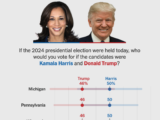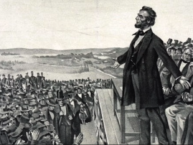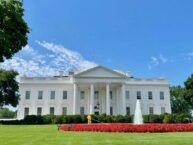By Glynn Wilson –
Public Opinion Analyst –
With only five weeks to go until the election on Nov. 5, the stakes could not be higher as the latest public opinion polls still show a close race for president.
Although the latest compilation average of all the polls show that Democrat Kamala Harris leads Republican Donald Trump by a solid three percentage points, so she is set to win the national popular vote.
The race remains close in all the key battleground states, however, so it’s still too close to call.
“While the race remains extraordinarily close in the seven key battleground states,” according New York Times public opinion analyst Nate Cohn, “no candidate enjoys a significant lead in states worth the 270 electoral votes needed to win.”
Over the past few weeks, he says, the polls have been remarkably steady, with no clear indications of any meaningful shift either way.
“Still, there is something different about the polls this past week,” he says. “It’s not a difference in the top-line numbers, but the context: This was a relatively calm week of political news, at least compared with the last few months. As a result, this might be the clearest read we’ve had of the race so far. It was arguably the first ‘quiet’ week since Vice President Harris’s entry into the race.”
He reminds readers of what’s happened from late July to mid-September.
“Over just that short span, Ms. Harris became her party’s nominee; she selected her vice-presidential running mate; the Democrats held their convention; Ms. Harris and Mr. Trump debated; and then an assassination attempt against Mr. Trump was thwarted on Sept. 15.”
At every stage, he says, these events made it harder to be sure the polls were offering a relatively unvarnished assessment of the race.
“It was reasonable to wonder, for instance, whether Ms. Harris’s standing was being inflated by a series of media-driven bounces,” he says. “Good news for Mr. Trump, on the other hand, could be interpreted as a sign that an earlier Harris bounce was fading.”
This week, he says, it’s getting easier to trust that the news isn’t driving the numbers. It’s been three weeks since the debate and two weeks since the assassination attempt, and there’s been plenty of nonpolitical news in the headlines. This includes the Fed cutting interest rates, the disaster of Hurricane Helene and the Israeli attacks on Hezbollah.
There are a few hints, he claims, that Harris’s numbers have slipped a bit since the post-debate polls, although these days pollsters have to weight the numbers in Trump’s favor a bit because of the problem of getting conservatives to answer cell phone calls from pollsters.
“But on balance, a relatively calm and neutral political environment returned and it didn’t require any major revision to our understanding of the race,” he says. “As a result, we can be more confident in this week’s state of the race roundup, even though the numbers don’t look very different.”
What if the polls are wrong?
“While a relatively quiet political environment makes us more confident in the state of the race, there are still no guarantees,” he says. “If the polls are off as they were two or four years ago, the outcome might be very different than the polls suggest today…”
Arizona and Pennsylvania
While the poll averages didn’t move much last week, they did budge in Pennsylvania and Arizona, two states where there was the most new high-quality polling. In each case, the averages shifted a tad toward Trump, he said, “though not enough to change the big picture.”
In the reckoning of the average, he says, Pennsylvania is now virtually a dead heat. Harris’s lead is under one point, well within the margin of error. Fox News, Susquehanna and Muhlenberg College polls all showed a tie there as well.
“This raises the possibility of a slight dip for Ms. Harris in Pennsylvania,” Cohn says, “as she led by about two points in a wave of high-quality polls immediately after the presidential debate.”
An unusually large share of the high-quality polling post-debate was focused on Pennsylvania, he points out, so it’s possible that a receding post-debate bounce would only be discernible in Pennsylvania.
Arizona is the other state with plenty of high-quality polling, he says, and it’s now the battleground state where Trump fares best in the averages. He shows a two-point lead, still within the margin of error.
The balance of the high-quality polling in Arizona this past week was arguably even better for Trump. He leads by six points in a USA Today/Suffolk poll, by three in a Fox poll, by one via Marist, and by five in the Times/Siena poll released last Monday.
But according to our analysis of the Electoral College scenarios, Harris does not need to win Arizona to win the election. Even if Trump carries Arizona, Nevada, North Carolina and Georgia, all Harris has to do is win in Minnesota, Wisconsin, Michigan and Virginia – and of course Pennsylvania.
Two Months to Go Until Nov. 5: Will American Democracy Survive?
Hispanic Voters
One factor in Trump’s strength appears to be Arizona’s Hispanic vote. Of the four high-quality polls released this past week, none showed Harris leading among Hispanic voters by more than 12 points, even though most estimates suggest President Biden won by at least 20 points among Hispanic voters when he narrowly carried the state in 2020.
A new national snapshot of the Hispanic vote was revealed in two high-quality polls of Hispanic voters conducted by Pew Research and NBC News/Telemundo. The polls told the same story: Trump is doing better among Hispanic voters than four years ago, when Biden carried them by 62-36 percent.
NBC/Telemundo showed Harris up by just 14 points among Hispanic voters, 54-40, while Pew Research found her up by 18, 57-39.
The two tallies are similar to a compilation of Times/Siena national polls, which have shown Harris up by 56-39 among Hispanic voters.
Trump’s strength among Hispanic voters this cycle might seem surprising, Cohn says, but four years ago he made big gains among them across the country. In 2016, he fared no worse than Mitt Romney’s 2012 showing, even though his anti-immigration rhetoric created the expectation of a significant backlash. In retrospect, his resilience among Hispanic voters in 2016 looks like a harbinger of what was to come.
This time, his strength might help him in two states with large Hispanic populations, Arizona and Nevada. It might also help him in the national popular vote, as Hispanic voters disproportionately live in noncompetitive states like California and Texas.
Nonetheless, a good showing for Trump among Hispanic voters won’t do as much for him in the states that seem to represent Harris’s best path to victory: Pennsylvania, Michigan and Wisconsin.
About the Author
Glynn Wilson is an expert on public opinion as an academic researcher and a journalist. He minored in Political Science with a major in Journalism and Communications at the University of Alabama in an undergraduate BA program back in the early 1980s, where he took every class offered related to this specialty. He also spent some time working with the Capstone Poll in those days, run by Political Science Professor Pat Cotter, and journalism professor Jim Stovall. He covered public opinion for newspapers and the UPI wire service after that for 10 years as part of the beat of covering public affairs and politics, including elections. He then went back to grad school at UA in the mid-1990s. One of his graduate research jobs was to oversee the public opinion lab in the College of Communications, also under the leadership of Stovall and Cotter, who conducted most of the political election polls in Alabama for a couple of decades. Wilson’s academic research specialty was in the area of media effects on public opinion. He later worked toward a Ph.D. in this research, but rather than continue teaching and jump through the final hoop of defending a dissertation at the University of Tennessee, he opted to go back into the news business working for The Dallas Morning News, The New York Times and other publications. He went independent on the web in 2005 in the early blogging era when newspapers were experiencing financial troubles, and has covered public opinion ever since as one of his many specialty beats.
___
If you support truth in reporting with no paywall, and fearless writing with no popup ads or sponsored content, consider making a contribution today with GoFundMe or Patreon or PayPal.















